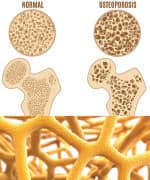Life Extension Magazine®
With age, our bones get thinner and weaker.
This leads to increased fractures that are leading causes of disability as people age past 50 years.1
The numbers are chilling. Within a year of suffering a hip fracture, up to 20% of patients will die.1 And almost any kind of broken bone increases the risk of death in older people.2
Physicians in Japan discovered a way to help prevent bone loss and protect against fractures.
For more than two decades they have been prescribing a high-dose vitamin K2 in the form of menaquinone-4 or MK4.3
This high-dose vitamin K, used as a prescription drug in Japan, is now available as a dietary supplement.
Vitamin K is found in small amounts in many foods and over-the-counter formulas. But at the high dose of 45 mg, it has a profound impact, helping to:4-11
- Slow bone loss,
- Build new bone, and
- Reduce fracture risk.
In a two-year study on older people with osteoporosis, high-dose vitamin K2 cut the number suffering a vertebral fracture by half.11
Along with other nutrients known to support bone strength, vitamin K2 plays an essential role in maintaining and helping to restore bone density.
What Causes Bone Loss?

To maintain structure, old bone is constantly being broken down, and new bone is being built up.
For the first decades of life, bone density (how tightly bones are packed with minerals) increases. Peak bone density and bone strength then plateau for about two decades.
By age 40, bone density starts to fall and continues to decline into old age. In women, the speed of bone loss accelerates with the onset of menopause.
That drop in bone-mineral density leads to a reduction in bone strength. Bones become brittle and prone to fractures, even from minor injuries (or stress fractures that occur during normal use).
The early stage of bones weakening is called osteopenia.
As bone density continues to drop, osteoporosis develops, which means “bone full of pores or holes.”
Most people don’t know they have osteopenia or osteoporosis until it’s too late—when they suffer a fracture.
High Doses of Vitamin K2
The encouraging news is there is something we can do about age-related bone loss and risk of fractures.
Vitamin K2 has been used to treat osteoporosis in Japan for decades.3
Research has confirmed that this specific form of vitamin K is critical for bone health and other aspects of healthy aging.
In low doses (60 mcg), vitamin K promotes normal blood clotting. This small amount of vitamin K is normally obtained from dietary sources.
Beginning in 1999, scientists at Life Extension® recognized that higher doses of vitamin K can better keep calcium in bones and help prevent calcification of soft tissues such as heart valves, arteries, and brain cells.
As data accumulated over the past 21 years, the suggested daily dose of vitamin K steadily increased to over 2,000 mcg, which is far higher than the tiny amount needed for normal blood coagulation.
Vitamin K2 Safety Profile
What’s interesting is how vitamin K functions to enable normal coagulation.
Once low doses activate coagulation proteins in the liver, then no matter how much more vitamin K is ingested, there is no excess coagulation/clotting risk. That’s because when coagulation proteins are fully saturated with vitamin K, they cannot take up more vitamin K to cause greater coagulation potential.
With this understanding, the opportunity to use far higher vitamin K doses to build strong bones became an enticing reality.
So much so that Japanese doctors began prescribing 45,000 mcg of vitamin K2 and have verified profound improvements in bone health in older adults.3
Building New Bone

Bone density is influenced by two types of bone cells: osteoclasts and osteoblasts.
Osteoclasts break down old bone. Osteoblasts build new bone.
Healthy bone relies on a balance of activity between these two types of cells. They constantly remodel bone structure while keeping bone density stable.
As we age, this balance is lost. Osteoclast activity outweighs osteoblast activity. As a result, bone is broken down faster than new bone can be built up. As bone density drops, osteopenia and osteoporosis manifest.
Vitamin K2 appears to restore healthy balance. In preclinical studies, it promotes an increase in bone-building osteoblast activity and reduces osteoclast activity.12,13 With this balance restored, more bone is built, less is destroyed, and bone mineral density is maintained or even increased.
In addition, in order to lay down new bone, osteoblasts need a protein called osteocalcin. This protein binds to calcium, helping osteoblasts turn calcium into healthy new bone.13 Vitamin K2 helps convert osteocalcin into its active form.13,14
What you need to know
Prevent Fractures with Vitamin K2
- Bone loss begins to occur in our 40s and progresses with advancing age.
- This weakening of bone can lead to osteoporosis and greatly increased risk of fractures, which can cause disability and dramatically increase risk of death.
- High-dose vitamin K2 has been used as a treatment for osteoporosis in Japan for decades.
- Vitamin K2 acts by several mechanisms to improve bone health in preclinical studies, including restoring balance to the process of bone breakdown and formation.
- Human trials have shown that daily intake of 45 mg (45,000 micrograms) of vitamin K2 maintains or increases bone density and reduces the risk of fractures.
- Other nutrients, including calcium and vitamin D3, also support bone health and help maximize vitamin K2’s benefits.
Keeping Bones Strong
Human trials have tested the benefits of vitamin K2 on bone health.4-11
The results show that high-dose vitamin K2:
- Increases active osteocalcin levels required for new bone formation, and
- Maintains or increases bone mineral density.
Many of these studies have been performed in older people with osteoporosis. Even those already at this advanced level of bone loss benefit from oral vitamin K2.
One example comes from researchers in Japan.11 They enrolled older individuals in a study who all had a diagnosis of osteoporosis. Patients were randomized to receive either calcium alone or calcium plus 45 mg of vitamin K2 daily.
Over the course of the two-year study, subjects who received only calcium continued to lose bone density, dropping by about 3%.
A 10% drop in bone density more than doubles the risk for fractures of the vertebra (the bones making up the spine) and hip.15 This means that those treated only with calcium in this study (who lost 3% of bone density) increased their risk of fracture.
On the other hand, people receiving high-dose vitamin K2 in addition to calcium largely maintained their bone mineral density. They also benefited from a significant increase in levels of active osteocalcin.
Reducing Fracture Risk

The scale of osteoporosis and related fractures is staggering.
Worldwide, as many as one-third of women and one-fifth of men over age 50 will suffer an osteoporotic fracture.1 And after suffering one fracture, the risk of future fractures increases by a whopping 86%.1
Fractures of the hip and vertebra in particular are associated with pain, loss of mobility, and risk of death.1 For example, people who suffer a vertebral fracture have an 8-fold increase in mortality compared to other individuals their age.1
In the Japanese study on older people with osteoporosis, 30% of those receiving only calcium suffered vertebral fractures during the two years of the study. But only 14% of those also receiving high-dose vitamin K2 + calcium had a vertebral fracture.11 (These study subjects did not receive supplements like vitamin D and magnesium, also needed to protect aging bones.)
Another Japanese clinical trial found that 45 mg of vitamin K2 daily maintained bone mineral density and reduced the risk of fractures.6
Vitamin K2 and Bisphosphonates
The bisphosphonates are a group of drugs prescribed to slow bone loss in osteoporosis. They include medications such as alendronate, risedronate, and others.
Research shows that vitamin K2 does not interfere with bisphosphonates and can safely be used at the same time. There are even some data to suggest that they may have an additive effect, protecting bone density better together than either one alone.28
Nutrients That Work with Vitamin K2

As in all aspects of health, no one nutrient is enough on its own. Vitamin K works with other nutrients to form healthy bone.
The following nutrients have been shown to keep bone-density levels up and to maximize the benefits of vitamin K2:
- Calcium is the major mineral that forms the hard, strong matrix of bone. Adequate calcium is needed so that osteoblasts have it readily available to build bone tissue.
- Vitamin D helps absorb calcium from the gut after a meal and stimulate the production of the protein osteocalcin, needed to form new bone.14
- Magnesium, like calcium, makes up the mineral matrix of bone. Adequate levels are needed to maintain healthy bone density.16
- Zinc, Manganese, Silicon, and Boron. These minerals have been shown to be important for optimal bone formation and health. Low intake of each of these minerals is associated with bone loss, and increased intake improves bone health in animal models and in humans.17-27
Taken together with high doses of vitamin K2, these nutrients protect against bone loss and fractures.
Cardiovascular Disease Benefits
Vitamin K2 promotes new bone growth in part by increasing calcification, the buildup of calcium deposits, in the bone.
However, in soft tissues, calcification can be extremely dangerous. In blood vessels, it leads to the buildup of atherosclerotic plaques associated with cardiovascular disease.
Remarkably, research has shown that while vitamin K2 causes beneficial calcification in bones, it prevents harmful calcification in soft tissues, including blood vessels.29,30 This occurs because it activates matrix Gla protein, which inhibits calcification of blood vessels.
For this reason, vitamin K2 may be protective against cardiovascular disease.31
In addition, while vitamin K1 is used to help blood clot in response to blood vessel injury, vitamin K2 has not shown any impact on clotting or coagulation.32 Still, anyone taking warfarin, a powerful anticoagulant, should consult a physician before deciding to take any form of vitamin K.
Summary
As our bones become thinner and weaker with age, the risk of dangerous and life-threatening fractures increases.
High-dose vitamin K2 has been used to treat the bone disease osteoporosis for decades in Japan.
Clinical trials demonstrate that daily intake of 45 mg of vitamin K2 maintains or increases bone-mineral density and reduces the risk of fractures.
Along with other vitamins and minerals crucial for bone health, vitamin K2 is a powerful tool to help build stronger, healthier bones well into old age.
If you have any questions on the scientific content of this article, please call a Life Extension® Wellness Specialist at 1-866-864-3027.
References
- Available at: https://www.osteoporosis.foundation/facts-statistics/epidemiology-of-osteoporosis-and-fragility-fractures. Accessed July 7, 2020,
- Tran T, Bliuc D, Hansen L, et al. Persistence of Excess Mortality Following Individual Nonhip Fractures: A Relative Survival Analysis. J Clin Endocrinol Metab. 2018 Sep 1;103(9):3205-14.
- Iwamoto J. Vitamin K(2) therapy for postmenopausal osteoporosis. Nutrients. 2014 May 16;6(5):1971-80.
- Binkley N, Harke J, Krueger D, et al. Vitamin K treatment reduces undercarboxylated osteocalcin but does not alter bone turnover, density, or geometry in healthy postmenopausal North American women. J Bone Miner Res. 2009 Jun;24(6):983-91.
- Iwamoto J, Takeda T, Ichimura S. Effect of combined administration of vitamin D3 and vitamin K2 on bone mineral density of the lumbar spine in postmenopausal women with osteoporosis. J Orthop Sci. 2000;5(6):546-51.
- Iwamoto J, Takeda T, Ichimura S. Effect of menatetrenone on bone mineral density and incidence of vertebral fractures in postmenopausal women with osteoporosis: a comparison with the effect of etidronate. J Orthop Sci. 2001;6(6):487-92.
- Jiang Y, Zhang ZL, Zhang ZL, et al. Menatetrenone versus alfacalcidol in the treatment of Chinese postmenopausal women with osteoporosis: a multicenter, randomized, double-blinded, double-dummy, positive drug-controlled clinical trial. Clin Interv Aging. 2014;9:121-7.
- Purwosunu Y, Muharram, Rachman IA, et al. Vitamin K2 treatment for postmenopausal osteoporosis in Indonesia. J Obstet Gynaecol Res. 2006 Apr;32(2):230-4.
- Takahashi M, Naitou K, Ohishi T, et al. Effect of vitamin K and/or D on undercarboxylated and intact osteocalcin in osteoporotic patients with vertebral or hip fractures. Clin Endocrinol (Oxf). 2001 Feb;54(2):219-24.
- Ushiroyama T, Ikeda A, Ueki M. Effect of continuous combined therapy with vitamin K(2) and vitamin D(3) on bone mineral density and coagulofibrinolysis function in postmenopausal women. Maturitas. 2002 Mar 25;41(3):211-21.
- Shiraki M, Shiraki Y, Aoki C, et al. Vitamin K2 (menatetrenone) effectively prevents fractures and sustains lumbar bone mineral density in osteoporosis. J Bone Miner Res. 2000 Mar;15(3):515-21.
- Akbari S, Rasouli-Ghahroudi AA. Vitamin K and Bone Metabolism: A Review of the Latest Evidence in Preclinical Studies. Biomed Res Int. 2018;2018:4629383.
- Palermo A, Tuccinardi D, D’Onofrio L, et al. Vitamin K and osteoporosis: Myth or reality? Metabolism. 2017 May;70:57-71.
- van Ballegooijen AJ, Pilz S, Tomaschitz A, et al. The Synergistic Interplay between Vitamins D and K for Bone and Cardiovascular Health: A Narrative Review. Int J Endocrinol. 2017;2017:7454376.
- Available at: https://www.ncbi.nlm.nih.gov/books/NBK45525/. Accessed September 28, 2020.
- Matsuzaki H. [Prevention of osteoporosis by foods and dietary supplements. Magnesium and bone metabolism]. Clin Calcium. 2006 Oct;16(10):1655-60.
- Aydin H, Deyneli O, Yavuz D, et al. Short-term oral magnesium supplementation suppresses bone turnover in postmenopausal osteoporotic women. Biol Trace Elem Res. 2010 Feb;133(2):136-43.
- Bae YJ, Kim JY, Choi MK, et al. Short-term administration of water-soluble silicon improves mineral density of the femur and tibia in ovariectomized rats. Biol Trace Elem Res. 2008 Aug;124(2):157-63.
- Dimai HP, Porta S, Wirnsberger G, et al. Daily oral magnesium supplementation suppresses bone turnover in young adult males. J Clin Endocrinol Metab. 1998 Aug;83(8):2742-8.
- Hyun TH, Barrett-Connor E, Milne DB. Zinc intakes and plasma concentrations in men with osteoporosis: the Rancho Bernardo Study. Am J Clin Nutr. 2004 Sep;80(3):715-21.
- Kim MH, Bae YJ, Choi MK, et al. Silicon supplementation improves the bone mineral density of calcium-deficient ovariectomized rats by reducing bone resorption. Biol Trace Elem Res. 2009 Jun;128(3):239-47.
- Nielsen FH. Studies on the relationship between boron and magnesium which possibly affects the formation and maintenance of bones. Magnes Trace Elem. 1990;9(2):61-9.
- Nielsen FH, Lukaski HC, Johnson LK, et al. Reported zinc, but not copper, intakes influence whole-body bone density, mineral content and T score responses to zinc and copper supplementation in healthy postmenopausal women. Br J Nutr. 2011 Dec;106(12):1872-9.
- Rico H, Gallego-Lago JL, Hernandez ER, et al. Effect of silicon supplement on osteopenia induced by ovariectomy in rats. Calcif Tissue Int. 2000 Jan;66(1):53-5.
- Strause L, Saltman P, Smith KT, et al. Spinal bone loss in postmenopausal women supplemented with calcium and trace minerals. J Nutr. 1994 Jul;124(7):1060-4.
- Yamaguchi M. Role of nutritional zinc in the prevention of osteoporosis. Mol Cell Biochem. 2010 May;338(1-2):241-54.
- Yamaguchi M, Weitzmann MN. Zinc stimulates osteoblastogenesis and suppresses osteoclastogenesis by antagonizing NF-kappaB activation. Mol Cell Biochem. 2011 Sep;355(1-2):179-86.
- Plaza SM, Lamson DW. Vitamin K2 in bone metabolism and osteoporosis. Altern Med Rev. 2005 Mar;10(1):24-35.
- El Asmar MS, Naoum JJ, Arbid EJ. Vitamin k dependent proteins and the role of vitamin k2 in the modulation of vascular calcification: a review. Oman Med J. 2014 May;29(3):172-7.
- van den Heuvel EG, van Schoor NM, Lips P, et al. Circulating uncarboxylated matrix Gla protein, a marker of vitamin K status, as a risk factor of cardiovascular disease. Maturitas. 2014 Feb;77(2):137-41.
- Harshman SG, Shea MK. The Role of Vitamin K in Chronic Aging Diseases: Inflammation, Cardiovascular Disease, and Osteoarthritis. Curr Nutr Rep. 2016 Jun;5(2):90-8.
- Asakura H, Myou S, Ontachi Y, et al. Vitamin K administration to elderly patients with osteoporosis induces no hemostatic activation, even in those with suspected vitamin K deficiency. Osteoporos Int. 2001 Dec;12(12):996-1000.

